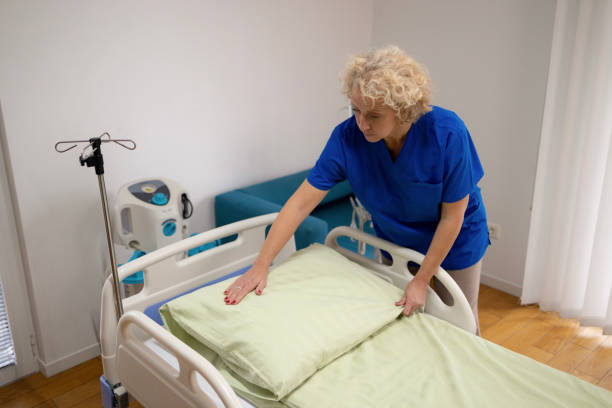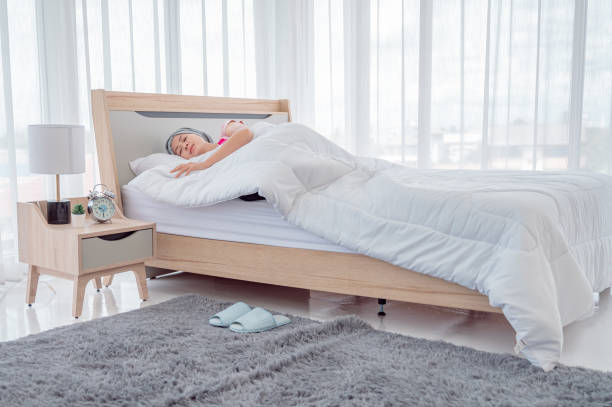Introduction

When managing Parkinson's disease, ensuring a safe and comfortable environment is of utmost importance. While various aspects of daily life require attention, providing a suitable bed setup for individuals with Parkinson's can significantly enhance their well-being and overall sleep quality. As Parkinson's disease can affect mobility, balance, and motor skills, it becomes crucial to design a bed arrangement that minimizes the risk of falls, maximizes comfort, and promotes a restful night's sleep.
This blog post will explore key considerations and practical tips for ensuring a safe and comfortable bed setup tailored specifically for Parkinson's patients. By implementing these strategies, you can help create an environment that supports their unique needs and promotes their overall health and well-being.
What is Parkinson's disease?
Parkinson's is a neurological disorder that affects the brain and causes movement issues. Symptoms of Parkinson's disease may include tremors, slowed movements, and difficulty with fine motor skills such as writing. It can also cause stiffness in the body and problems with balance. As the condition progresses, mobility often becomes more challenging for those affected.
Ensuring a Safe and Comfortable Bed Setup for Parkinson's Patients

Creating a safe and comfortable bed setup for someone with Parkinson's disease is important to ensure they can sleep comfortably and maximize their mobility. Here are 10 tips for setting up the perfect sleeping environment:
- Select a mattress with the right support for your individual needs. A firm mattress can help keep the body in proper alignment, particularly if you experience stiffness or pain associated with Parkinson's disease.
- Consider using adjustable beds for easier positioning and increased comfort levels. This bed type allows you to independently adjust the head and foot sections for customizable support.
- Use a supportive pillow to help maintain proper head, neck, and spine alignment when sleeping on your back or side.
- Invest in a mattress protector to keep your bedding clean and free of bacteria or allergens that can cause irritation and discomfort.
- Place non-slip rugs next to the bed to provide extra traction and minimize the risk of falls.
- Add a grab bar to the side of the bed for safety and support when getting in or out of bed.
- Place night lights around the bedroom to make it easier to navigate during nighttime trips to the bathroom or for other activities
- Make sure the bedding is soft, comfortable and easy to move on. Choose smooth breathable fabrics that have moisture-wicking properties to help stay dry and comfortable from night sweats.
- Consider using a recliner chair in the bedroom as an alternative sleeping position if difficulty getting into bed becomes an issue. But also be aware that friction-reducing sheets and sleepwear make moving in and out of bed easier thereby reducing the need to sleep in a reclining chair. Additionally, if sleeping in a chair is still preferable, such friction-reducing textiles can be used on a chair or couch.
- Check for loose objects on the floor that can become tripping hazards. This is especially important if a person needs a walker or wheelchair for mobility.
By taking the time to create an appropriate sleeping environment, individuals with Parkinson's disease are enabled to rest more comfortably and increase their daily mobility.
Are there any specific exercises or stretches that can help with mobility and comfort in bed for Parkinson's patients?

Yes, some exercises and stretches can help with mobility and comfort in bed for Parkinson's patients. Stretching the limbs and the neck gently is very important to reduce stiffness. Light aerobic exercises like walking or cycling can also help. Flexibility exercises like yoga and tai chi improve balance, flexibility, and posture.
It's also important to pay attention to ergonomics when designing a comfortable sleeping space for people with Parkinson's, as the right sheets and sleepwear for ease of mobility, pillow or mattress can make a huge difference in comfort. Finally, regular massage therapy can help to reduce stress levels and improve mobility. As always, talking with your doctor or physical therapist is important to determine the best exercise plan for your needs.
Are there any special pillows or cushions that can improve comfort for Parkinson's patients?
Yes, several special pillows and cushions are designed to help improve comfort for Parkinson's patients. These products are specifically engineered to provide optimal support for individuals with Parkinson's, helping them stay comfortable while sleeping or sitting in chairs. Special features may include adjustable firmness levels, temperature-sensitive foam material, and ergonomic positioning.
These pillows and cushions are designed to help reduce discomfort associated with Parkinson's symptoms, such as muscle spasms, tremors, and stiffness. They may also help improve circulation in affected areas of the body, helping to keep joints flexible and reducing pain. If you suffer from painful side effects from Parkinson's, using a pillow or cushion designed specifically for the condition can provide relief and improved comfort.
Suppose you consider purchasing a special pillow or cushion to help with Parkinson's symptoms. In that case, it is important to consult your healthcare provider and speak to them about the best product for you. They will be able to assess your symptoms and recommend the most appropriate product for your needs. It is also recommended to speak to an ergonomics or physical therapy specialist who can help you select the best pillow or cushion for optimal comfort.
Are there any bed accessories or assistive devices that can aid in the mobility of Parkinson's patients?
Yes, there are a variety of bed accessories and assistive devices that can aid in the mobility of Parkinson's patients. A more recent development is a sleep system consisting of a sheet and sleep garment combination. Used together, friction is minimized thereby allowing repositioning with considerably less effort. Some common bed aids include grab bars or handles to help provide support while getting into and out of bed, adjustable beds with motorized controls for ease of positioning, lift chairs that make it easier to stand up from a seated position, and bedside rails that help keep the patient from rolling out of bed. Specialized mattresses can also provide extra support and comfort for people with Parkinson's.
In addition to bed accessories, assistive devices such as mobility scooters or walkers can also be beneficial for getting around. Wheelchairs can also be used to help with mobility, as well as provide a safe and comfortable place to rest while out of the house.
Patients must be fitted properly for these devices to ensure their safety and comfort. Speak with your doctor or physical therapist about any assistive device you need. They can advise what device is best suited for your needs. Additionally, many local hospice and home health care centers can help fit patients with the appropriate assistive device.
It's important to be proactive about finding devices to help you live a comfortable life with Parkinson's disease. With the right bed accessories and assistive devices, you can more easily maintain mobility and independence for as long as possible.
If you have any questions about bed aides or assistive devices, don't hesitate to contact your local home health care center or physical therapist for more information. They can help you find the right device to fit your needs and lifestyle.
We understand that patients with Parkinson's disease can require special attention due to the complexity of their condition. As such, we have a range of measures in place to ensure the safety of these patients.
Finally, we provide a safe and supportive environment for our patients with Parkinson's disease. We believe in treating all our patients with compassion and respect and strive to make them comfortable. This helps us create a sense of security that allows everyone to receive the care they need without worrying about potential risks or complications.
Finally, we recommend a safe and supportive environment for patients with Parkinson's disease. We believe in treating all patients with compassion and respect and strive for maximal comfort. This helps to create a sense of security that allows everyone to receive the care they need.
FAQ's
How do you keep a Parkinson's patient in bed?
It is important to ensure that a Parkinson's patient has a comfortable and safe bed setup. This includes using special friction-reducing sheets and sleepwear for enhanced mobility, pillows or cushions designed specifically for the condition and assistive devices such as grab bars or adjustable beds with motorized controls.
What type of bed is best for Parkinson's patients?
The best bed type for Parkinson's patients is an adjustable bed with motorized controls. This allows the patient to easily adjust the bed to find a comfortable sleeping position. Additionally, it is recommended to use pillows and cushions specifically designed for individuals with Parkinson's.
How do you make someone with Parkinson's more comfortable?
Making a Parkinson's patient more comfortable can involve a variety of approaches. Creating an environment that is as safe and supportive as possible is important. This includes regular check-ins with healthcare providers, connecting the patient with specialists when needed, and ensuring all staff knows the latest research on treating Parkinson's disease.
What are the accessories for Parkinson's patients?
A variety of bed accessories and assistive devices can aid in the mobility of Parkinson's patients. These include friction-reducing sheets and sleepwear, grab bars or handles, adjustable beds, lift chairs, bedside rails, specialized mattresses, wheelchairs, mobility scooters, and walkers. It is important to consult with your healthcare provider or physical therapist before purchasing any of these accessories or devices. They can advise what type of device would best suit your individual needs and lifestyle.
Can Parkinson's patients be cared for at home?
Many individuals with Parkinson's can remain at home and receive care. The primary caregiver must provide the patient with a comfortable and safe environment to rest and restore. This includes setting up the bedroom with special bed accessories such as friction-reducing sheets and sleepwear, grab bars or adjustable beds, providing regular check-ins with healthcare providers, and connecting the patient with specialists when needed.
Do Parkinson's patients end up bedridden?
It is not common for Parkinson's patients to become bedridden though there are some circumstances where this does occur. With the right support and assistance, they can often remain active and maintain a high quality of life. Ensuring the patient has a safe and comfortable environment to rest and restore is important.
Conclusion
I hope this article has helped to provide an overview of how to ensure a safe and comfortable bed setup for Parkinson's patients. It is important to know the risks associated with the condition and what types of accessories and devices can help aid in their mobility. Additionally, creating a safe environment, connecting them with specialists when needed, and providing regular check-ins with healthcare providers can help ensure that the patient receives all the care they need.

